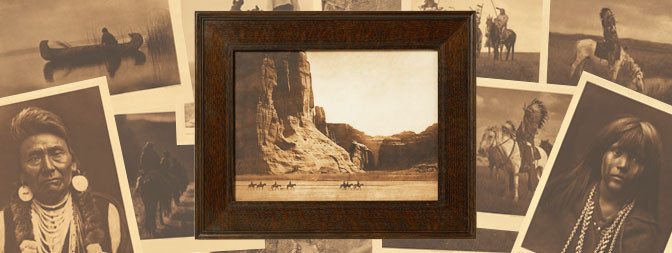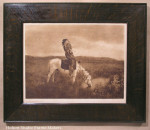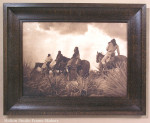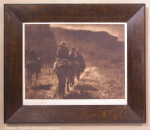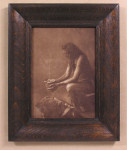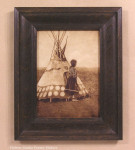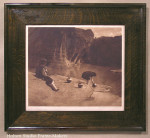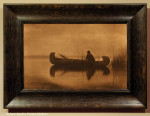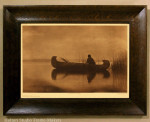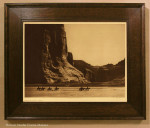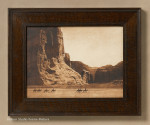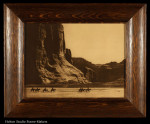Not only to do we love our role as a gallery representing Mountain Hawk’s extraordinary work, but we especially enjoy framing the prints. Our approach to framing is particularly well suited to period photos such as these. This page discusses the historical precedents for framing Curtises in dark oak frames and shows what we’ve done in the past. Its purpose is to offer ideas and recommendations for framing Mountain Hawk prints, as well as other Curtis images.
Historical Examples of Oak Frames on Curtis Prints
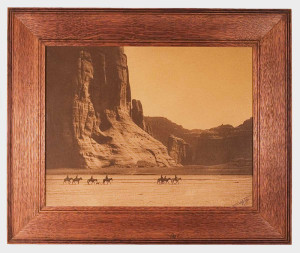 While original Curtis prints may be found in a variety of frames, Curtis himself appears to have preferred to frame them “close”—i.e., all the way to the image—in quartersawn oak frames, as he did in the two examples here. This was by no means an unusual framing approach in the day. Many artists, architects and designers believed in the ideal of restoring the original and natural unity of all the arts, not least of all the unity of pictures and architecture (the first paintings were murals). In that mission, frames were literally on the front line, and an effort was made to make the framed picture a unified object and do away with all separating elements and effects in the presentation. Part of the idea was that framing close better engaged the viewer. In this cause of greater unity and harmony int he arts, molding manufacturers a century ago offered a remarkable variety of oak frame profiles that included fine elements relating very harmoniously with the details of line and form captured by the camera. I feel confident in claiming that we’ve done more than any contemporary frame-maker in exploring and developing this beautiful, but largely ignored, genre of solid oak frames. Their simple, natural beauty, and the possibility for optimal harmony with the pictures, make them unbeatable choices for framing Mountain Hawk photogravures and Curtis prints generally.
While original Curtis prints may be found in a variety of frames, Curtis himself appears to have preferred to frame them “close”—i.e., all the way to the image—in quartersawn oak frames, as he did in the two examples here. This was by no means an unusual framing approach in the day. Many artists, architects and designers believed in the ideal of restoring the original and natural unity of all the arts, not least of all the unity of pictures and architecture (the first paintings were murals). In that mission, frames were literally on the front line, and an effort was made to make the framed picture a unified object and do away with all separating elements and effects in the presentation. Part of the idea was that framing close better engaged the viewer. In this cause of greater unity and harmony int he arts, molding manufacturers a century ago offered a remarkable variety of oak frame profiles that included fine elements relating very harmoniously with the details of line and form captured by the camera. I feel confident in claiming that we’ve done more than any contemporary frame-maker in exploring and developing this beautiful, but largely ignored, genre of solid oak frames. Their simple, natural beauty, and the possibility for optimal harmony with the pictures, make them unbeatable choices for framing Mountain Hawk photogravures and Curtis prints generally.
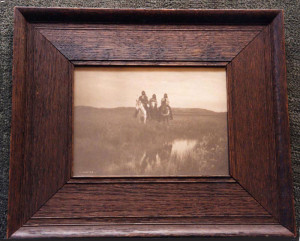 Quartersawn oak is our first choice of wood in most cases. Our Medieval Oak stain matches the sepia ink. If you prefer less coarse grain walnut with a light stain is a good choice. For most images, we like to frame “close” after Curtis’s own preference. Understandably, many people want to see the margin of the print, especially the text printed just below the image, as well as the plate mark (the embossed line, left by the copper plate, which outlines the image). So we sometimes frame close but to just outside the plate mark. The first row of images in the gallery below shows two prints treated in the two contrasting approaches. We’re also happy to mat the prints, in which case, a narrow frame is recommended. We suggest a simple solid core rag mat in a tan or buff color close to the color of the paper, or slightly darker and/or cooler.
Quartersawn oak is our first choice of wood in most cases. Our Medieval Oak stain matches the sepia ink. If you prefer less coarse grain walnut with a light stain is a good choice. For most images, we like to frame “close” after Curtis’s own preference. Understandably, many people want to see the margin of the print, especially the text printed just below the image, as well as the plate mark (the embossed line, left by the copper plate, which outlines the image). So we sometimes frame close but to just outside the plate mark. The first row of images in the gallery below shows two prints treated in the two contrasting approaches. We’re also happy to mat the prints, in which case, a narrow frame is recommended. We suggest a simple solid core rag mat in a tan or buff color close to the color of the paper, or slightly darker and/or cooler.
We look forward to helping you frame your Mountain Hawk or other Curtis print.
Read Tim’s article for Picture Framing Magazine on framing close…
Read Tim’s article in Style: 1900 on period oak frames, Hidden in Plain View: An Appreciation of the Oak Frame Tradition (PDF).
Framed Mountain Hawk Prints—
-
“An Oasis In the Badlands”
-
“The Storm—Apache”
-
“The Vanishing Race”
-
“Incense Over a Medicine Bundle—Hidatsa”
-
“A Piegan Plan Tipi”
-
“At the Old Well of Acoma”
-
“Kutenai Duck Hunter”
-
“Kutenai Duck Hunter”
-
“Canon de Chelly”
-
“Canon de Chelly”
-
“Canon de Chelly”
- “An Oasis In the Badlands”
- “The Storm—Apache”
- “The Vanishing Race”
- “Incense Over a Medicine Bundle—Hidatsa”
- “A Piegan Plan Tipi”
- “At the Old Well of Acoma”
- “Kutenai Duck Hunter”
- “Kutenai Duck Hunter”
- “Canon de Chelly”
- “Canon de Chelly”
- “Canon de Chelly”
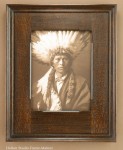 Other Framed Curtis Prints—
Other Framed Curtis Prints—
See more Curtis prints we’ve framed—ones not by Mountain Hawk—here...
